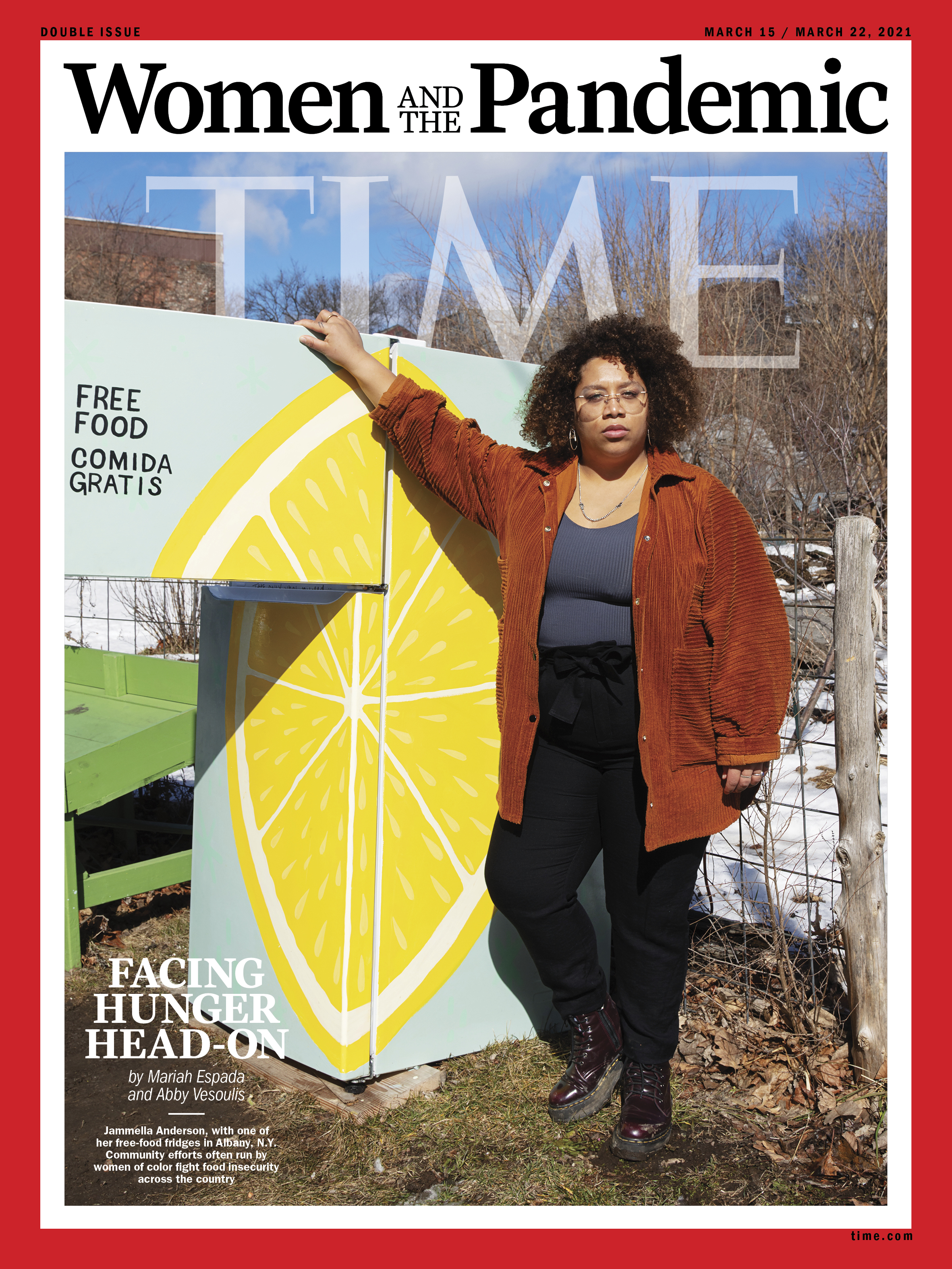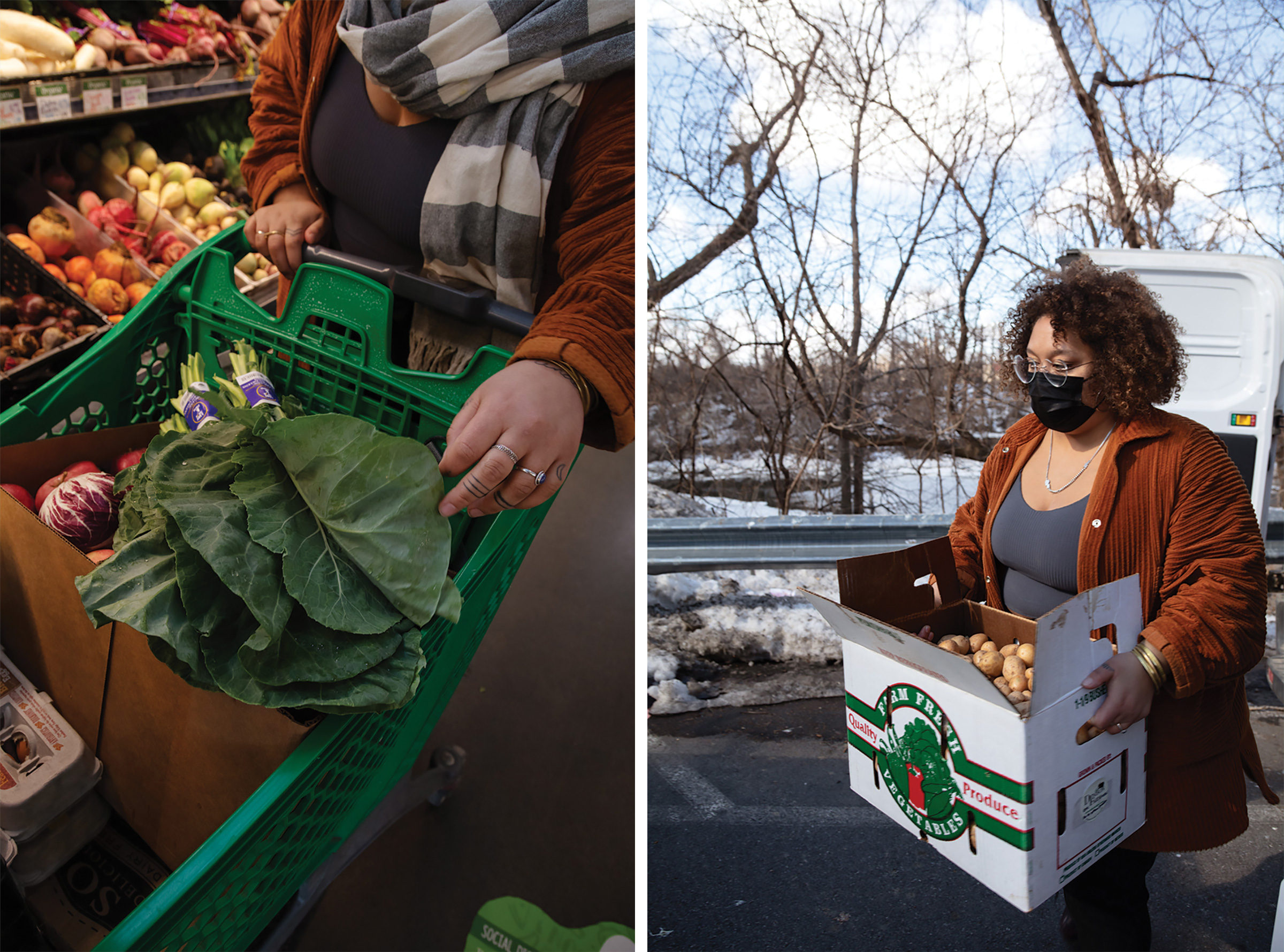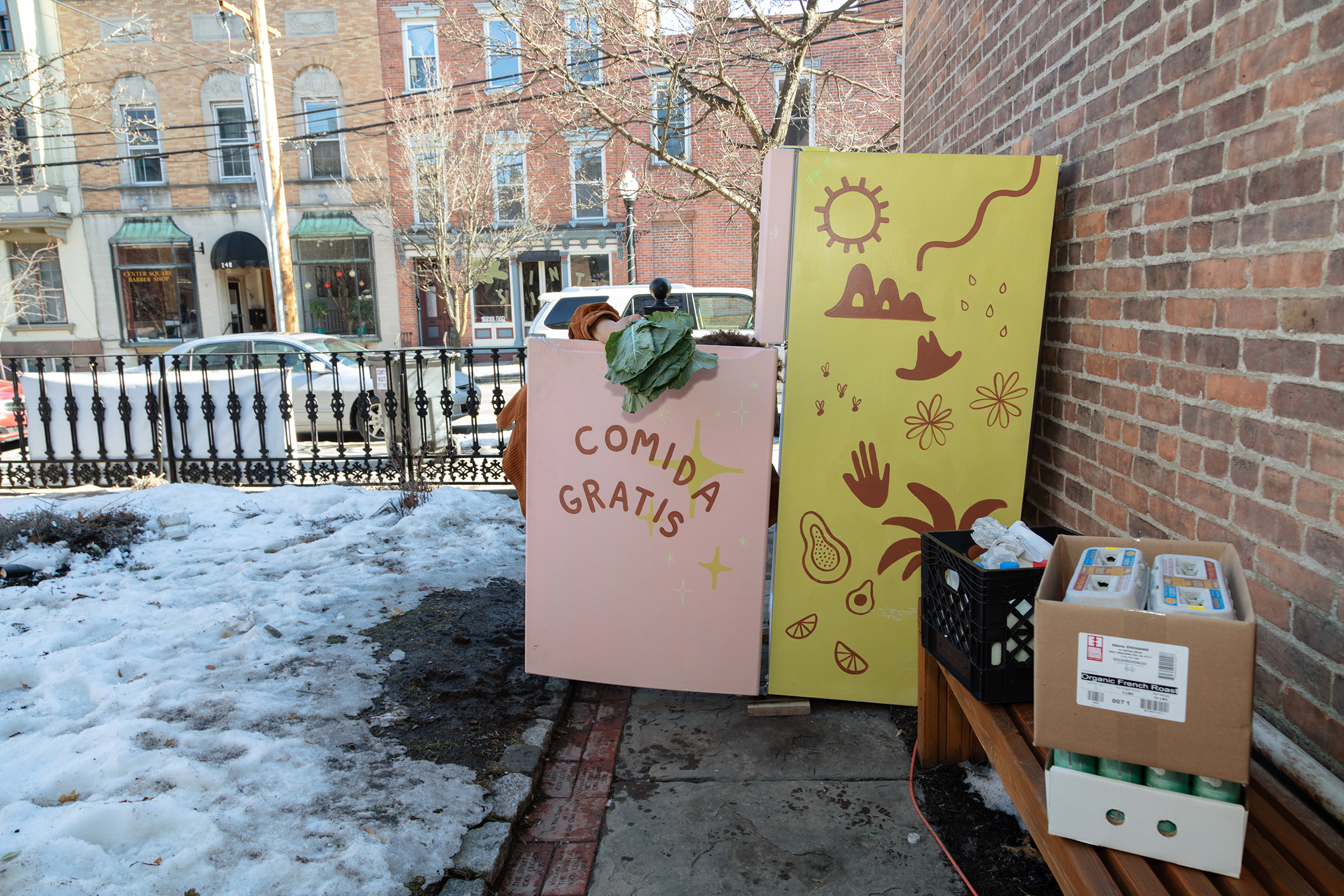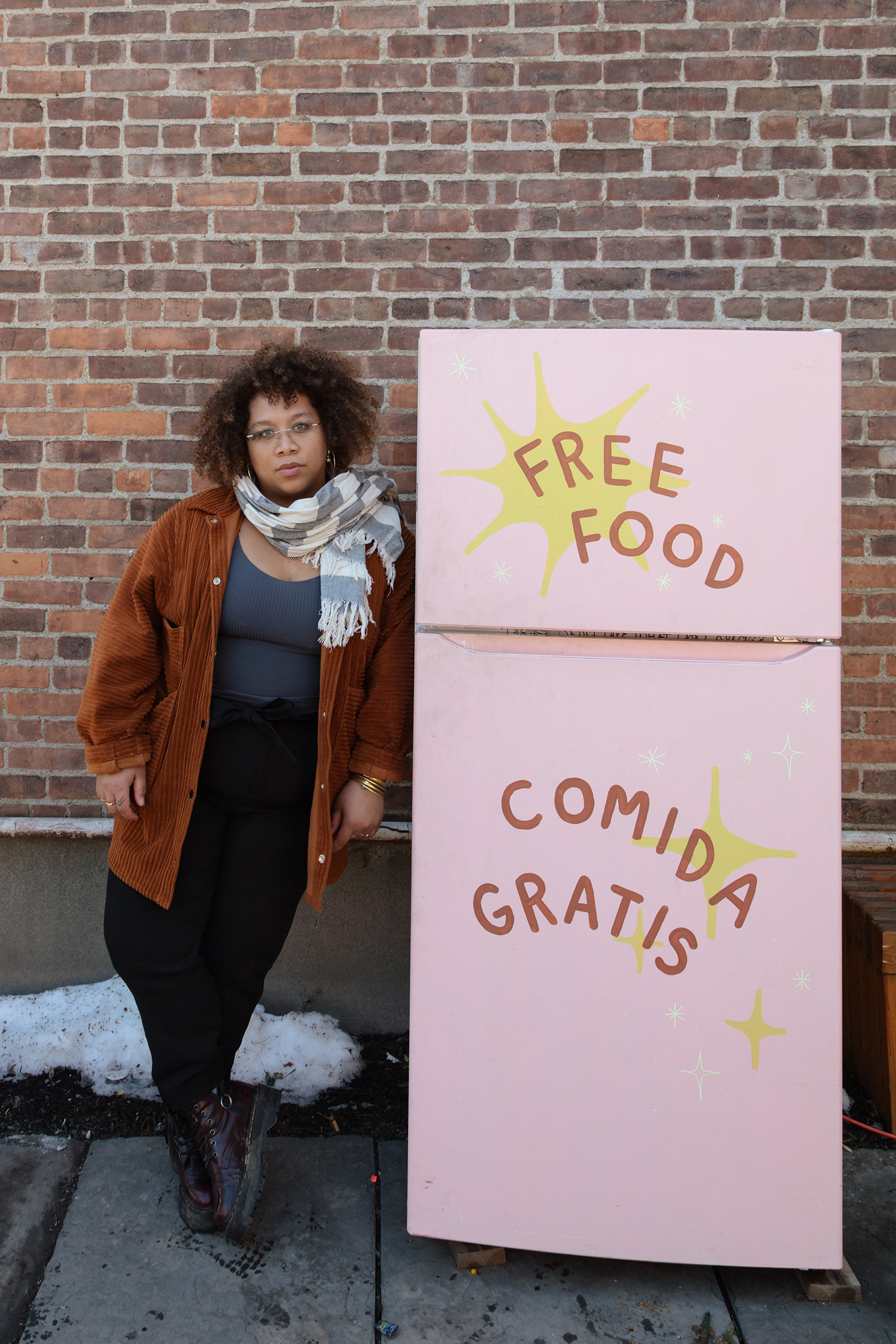Just before 3 p.m. on a warm Wednesday in February, 30-year-old Jammella Anderson—donning heart-shaped glasses, a Black Lives Matter tee and 2-in. platform boots—strolls up to a small bicycle-repair shop just north of Albany, N.Y. She’s here to persuade Troy Bike Rescue to let her use an electrical outlet so she can plug in a new refrigerator just outside the shop’s front door.
“It’s just two prongs,” she explains to one of the employees. “All I need is an outlet.”
Anderson, who works as a part-time doula and yoga instructor, is here on behalf of the one-woman organization she launched in August, Free Food Fridge Albany—an ad hoc network of half a dozen publicly accessible refrigerators that local farmers, market operators, restaurant owners and individual shoppers stock with free food multiple times each day to serve hungry people in the community. If Troy Bike Rescue’s owner agrees to give Anderson access to his electrical supply, Free Food Fridge Albany will be up to seven fridges citywide—a small but crucial service that helps thousands of local low-income families get enough to eat each month.

Even in flush times millions of Americans, including 11 million children, lack access to nutritious, affordable food. But in the past year the problem has become especially acute. When COVID-19 crippled the blue collar job market in March, the number of Americans who were “food insecure”—defined as those unable to access enough nutrition to live an active, healthy life—spiked from 11.5% in 2018 to an estimated 15.6% in 2020, according to an October projection by Feeding America, the largest domestic hunger-relief organization. For months, Americans have mobbed soup kitchens, waited in miles-long lines of cars to get rations from food banks and posted GoFundMe pages asking friends and strangers to chip in to cover groceries.
State and federal safety-net programs have not kept up with this crisis of demand. While Congress passed a relief package last March, it wasn’t until April that the Department of Agriculture boosted Supplemental Nutrition Assistance Program (SNAP) benefits by 40% in all 50 states. And even then, the language of the law excluded many of the poorest families—including the 12 million who were already receiving the maximum monthly SNAP allotment: $646 for a fourperson household in the majority of states. Eight months later, in December, Congress passed a second relief bill boosting benefits by 15% across the board, but that uptick is scheduled to expire this summer. Unless Congress extends it, millions of Americans will again be left to make ends meet with the prepandemic monthly amount—an average of about $1.39 per person per meal—which is based on a formula that hasn’t been revised since 2006.
Meanwhile, millions of Americans are falling through the cracks because they make just a hair too much each month to qualify for federal food assistance or are plagued by other financial burdens (like health care costs or student loans) that bleed into their grocery budgets. Deloria Floyd, 41, who is juggling nursing school and a full-time secretarial job at a hospital inundated with COVID-19 cases, makes roughly $37,000 per year, enough to disqualify her from federal assistance but not enough to cover healthy groceries to get her through 12-hour shifts. Without access to Anderson’s free food fridges, Floyd says, “I would be hungry. I would be losing weight.”

In the absence of a government solution, Anderson and an army of Good Samaritans around the country, many of whom are women of color, have stepped up. In New York City’s South Bronx, which is part of the poorest congressional district in the country, Tanya Fields runs the Black Feminist Project, an organization that helps locals grow their own food on a city-owned plot of land. In Los Angeles, the group Feed Black Futures, run by Ali Anderson (no relation to Jammella), provides organic, locally sourced produce to Black families who’ve been affected by incarceration, parole or probation. In Chicago, Erika Allen, Laurell Sims and their team at the Urban Growers Collective train new farmers and deliver hundreds of thousands of pounds of foods that are appetizing and enriching via a mobile food shop, standing produce outlets and emergency relief efforts. And in North Carolina, Ebonee Bailey runs a roving produce market named the Bulb that employs a take-what-you-need, give-what-you-can model. “If you want something done right, you call a woman,” Bailey says of food initiatives that have emerged in response to scarcity, “because we will handle it.”
Some of these activists were drawn to the work of providing accessible meals because they’ve known hunger in their own lives. Jammella Anderson, for example, was raised by a single mom in a family that relied on food stamps and Section 8 housing. She says her childhood shaped her understanding of her fridge clients’ needs and behaviors. Aware of the bureaucratic hurdles that her mother had to navigate to get federal aid, Anderson made the decision not to require the people who use her fridges to provide any proof of their financial situation or even give their names. She’s also not bothered when folks take as many groceries as they can carry, often emptying the fridges in a matter of hours. “If you grow up food-insecure like we have,” she says, “you sometimes want to take a lot because you don’t know when you’re going to get it again.”
To Anderson, access to a decent meal is a human right, not a luxury. “People used to ask all the time, ‘What if people steal the food?’” she says. “I always say, ‘You can’t. Because it’s free.’”
The problem of food insecurity in the U.S., one of the richest countries in the world, is ubiquitous across regions and ethnicities, but Black and Latino households are most vulnerable. They were more than twice as likely as white ones to experience food insecurity during various points in 2020, according to reports by the Urban Institute. The disparities remain today, though the percentage of food-insecure people across all races and ethnicities is getting higher. While 17% of white individuals in America faced food insecurity in February 2021, according to snapshot polling analyzed by Northwestern University, the rates among Black and Hispanic-Latino Americans were 30% and 31%, respectively.

These racial discrepancies are the result, in part, of a pattern of prejudice dating back decades. Until the 1960s, for instance, some states, including Louisiana and Illinois, denied Black families with children a cash benefit, a precursor of the modern program Temporary Assistance for Needy Families (TANF), if their labor was needed during harvest season. White families were often exempt from the cutoff. “Because it was Black families who had worked in the fields or chopped cotton, it was only Black families whose assistance was withheld,” says Elisa Minoff, a senior policy analyst at the Center for the Study of Social Policy. Through the 1970s, the federal food-stamp program also penalized the poor by making families buy food stamps, some of which could be used only on items that the Department of Agriculture had deemed surplus, like cornmeal and beans.
Anderson takes the opposite approach, asking local donors to avoid stocking the fridge with excess “scraps.” Instead, the fridges are stuffed with high-quality foods, like prepared spaghetti and meatballs from a local Italian bistro or grass-fed beef from a nearby farm. “Why are you undeserving of good, healthy food and rich-nutrient food just because you can’t afford it?” she says.
While SNAP and other federal food-aid programs have changed substantially since the ’60s, they still leave millions of Americans struggling to get enough to eat. A single person making more than $1,064 a month after taxes does not qualify for any SNAP funds at all, and those who do qualify often can’t feed their families on the amount provided, which maxes out at $2.60 per meal. Food-justice advocates also point to other factors—like the dearth of good grocery stores, outreach to vulnerable communities and reliable public transit in low-income areas—as contributing to the problem. Troy Bike Rescue, where Anderson is trying to set up another fridge, is a 31-stop bus ride and transfer from the nearest supermarket. In Garner, N.C., 52-year-old SNAP recipient Karrie Nelson says her current $200 monthly food-stamp allotment—almost twice as much as usual, thanks to the pandemic-relief increases—is less problematic than the fact that she can’t afford a car and public transit is insufficient. She estimates that she spends $450 per month on rideshare apps to commute to and from her job at a local grocery store, where she makes $12 an hour. “I can’t save because I’m spending half my paycheck getting back and forth to work,” she says.
That’s not an isolated problem, says Dr. Megan Sandel, who works with malnourished children and extremely low-income families as a co-director of the Grow Clinic at Boston Medical Center. Sandel says that by setting income ceilings low, not factoring in a recipient’s obligatory expenses like transportation, and reducing benefits every time somebody gets a modest pay bump, SNAP and other welfare programs often punish beneficiaries for building assets. If Nelson gets a raise that helps her buy a car, she may lose SNAP, forcing her to choose between gas and food.
These and other policy failures “play out on the bodies of babies,” Sandel says. Kids whose caregivers lose SNAP benefits are at greater risk of poor health, studies show. At the Grow Clinic, Sandel sees hundreds of malnourished children per year, including 2-year-olds who still fit into clothes meant for 1-year-olds and toddlers whose hair doesn’t grow, because of a combination of not getting enough nutrient-dense food and not getting enough food, period. Since March 2020, her clinic’s caseload has jumped 40%.

President Joe Biden is aware of the problem. Within his first week in office, he proposed the American Rescue Plan, which called on Congress to extend SNAP increases through the fall, and signed an Executive Order that directs the USDA to rejigger its formula to better reflect the costs of healthy foods.
But even if SNAP allotments increase, the number of hungry people is expected to remain high long after the virus is under control. “People get into a hole, and it takes a long time to get out,” says Elaine Waxman, a senior fellow at the Urban Institute. After the Great Recession, it took 10 years for food-security rates in America to near prerecession levels.
Many of the women serving their communities say they’re not holding their breath for a government solution. “We’ve been taking care of ourselves for a long time,” says Fields of the Black Feminist Project. “As much as the white folks think that food stamps and safety-net programs are what got us through, it hasn’t been. It’s been each other and the alternative models and systems of care that we’ve created.”
Back in Albany, Anderson grapples with the understanding that she—armed only with a 2015 black Ram van she named Marigold, some help from generous neighbors and unflagging resolve—can’t feed everyone on her own. On that February day, Anderson has already jammed Marigold with cases of kombucha, spinach and apples and is hoping to squeeze in more produce from a donor who runs a nearby farm. For now, she takes solace in helping to feed those she can. A few days later, she reports that she’s finalizing details with Troy Bike Rescue, which has agreed to give her a power outlet. That’s hundreds more people who don’t have to skip a meal.
Buy a print of TIME’s ‘Women and the Pandemic’ cover.
- The 100 Most Influential People of 2024
- Coco Gauff Is Playing for Herself Now
- Scenes From Pro-Palestinian Encampments Across U.S. Universities
- 6 Compliments That Land Every Time
- If You're Dating Right Now, You're Brave: Column
- The AI That Could Heal a Divided Internet
- Fallout Is a Brilliant Model for the Future of Video Game Adaptations
- Want Weekly Recs on What to Watch, Read, and More? Sign Up for Worth Your Time
